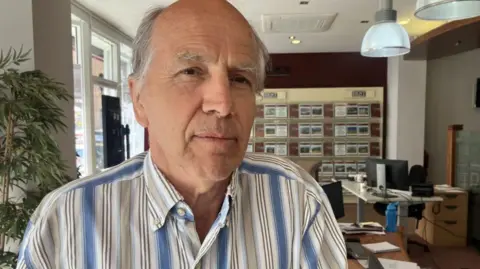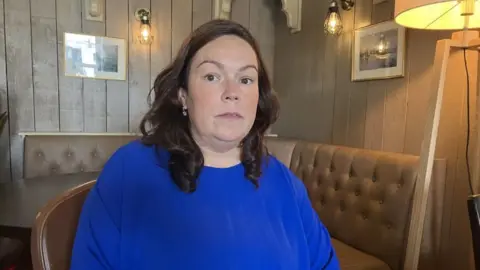Tourism hopes rise as bridge takes shape one year on
 BBC
BBCWith an estimated cost of about €100m (£84.3m), the Narrow Water Bridge aims to kickstart a new era of cross-border tourism on Carlingford Lough.
The bridge is being fully funded by the Irish government's Shared Island Unit and will link south Down in Northern Ireland with north Louth in the Republic of Ireland.
It aims to create a new tourist destination, incorporating the Mourne, Cooley and Ring of Gullion mountain ranges. But for this to happen, private investment must follow the Irish government's huge financial commitment.
There is already an early litmus test for how the bridge scheme is changing the tourist outlook for the area – the planned sale of the former Park Hotel in Omeath.

The hotel, which sits on an 85-acre site, a stone's throw from the bridge on the Republic of Ireland side, has been closed for nearly 20 years.
But, according to the man responsible for finding a buyer, the bridge development has already changed the outlook for sites like the Park Hotel.
"So far we're getting great interest so it's looking good," said Newry-based property agent Garry Best.
"We had discussions with the owner for the last three or four years but his preference was to wait until at least the bridge was started."
And it's hard to miss that building work.
In the water, there are more than 20 huge metal columns piled into the river bed where the bridge will be constructed.
Meanwhile, access roads are being created and improvements made to the road network on both the north and south sides.
Construction began 12 months ago and it is thought it will be completed by late 2027.
How do people feel about the bridge in Warrenpoint?

The sight of the work starting – and the promise of a completed bridge – is helping fuel investment in the area, the president of the Warrenpoint, Burren and Rostrevor Chamber of Commerce said.
Colleen Dowdell, who also helps run her family's pub in Warrenpoint, said people are hopeful it will lead to a number of eyesore sites in the town being upgraded.
There are some projects under way - an upgrade of the town's promenade and work on a building on Cole's Corner, which Ms Dowdall said has "probably been vacant since I was a child".
"But to see investment in the likes of the old Osborne Hotel on the seafront would be huge," she added.
"There's also not one person in this region who doesn't want to see the old baths on the seafront revitalised. That's what people hope will happen."

Meanwhile there have been other public investments on both sides of the border, which, while not necessarily connected to the bridge, are certainly complimentary.
These include public realm schemes on Warrenpoint and Omeath seafronts; the greenway linking Newry to Carlingford, which is nearing completion; and funding from the Irish government to develop a network of trails and water access points around Carlingford Lough.
There was also the recent news that the £44m Mourne Gondola project could be relocated to Kilbroney Park in Rostrevor – a move that would represent a significant tourism investment, albeit one that has received a mixed response in the region.
For those in favour, the project could help drive hundreds of thousands of visitors to the region each year but others hold environmental and economic concerns, as well as questions over whether Rostrevor's roads and car parking could handle an influx of visitors.
'High hopes' for the bridge in Rostrevor

That, in essence, is the big challenge – how to develop tourism in the area while being respectful to residents and the surrounding landscape.
Californian landscape artist Lauren Taylor, who owns a gallery in the centre of Rostrevor, said many tourism-facing businesses like hers have high hopes for the bridge.
"The ability to go all around the lough and visit Carlingford, Warrenpoint and Rostrevor in one day is really beneficial for the area," she said.
"It'll not only drive tourism but will attract small businesses like mine to settle into the area.
"It would be lovely to see more galleries, more boutiques, more small shops – all those things that tourists and locals want."
Carlingford Lough and tourism: A short history
For many around Carlingford Lough, the bridge represents a second chance for the region to establish itself.
Decades ago, trains and trams connected many of the towns around the lough - until 1965 trains ran to Warrenpoint, while Carlingford and Omeath were connected by rail until 1951.
There was also the Red Star Ferry, which ran regular services between Warrenpoint and Omeath.
But it wasn't just the demise of railways that damaged the region's appeal for tourists – sitting flush on the border during the Troubles did little to entice visitors.

In August 1979, Narrow Water was the scene of an IRA double bomb attack which killed 18 British soldiers, while a civilian, William Hudson, was also killed by Army gunfire following the attack.
As a result, the bridge project has been met with a sense of unease for some in the unionist community.
But the growth in popularity of Carlingford village as a destination over the past 20 years saw the campaign for the bridge revitalised.
It was not until the launch of the Irish government's Shared Island Unit in 2021, that things took a major step forward leading to an official turning of the sod in June 2024.
